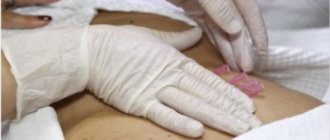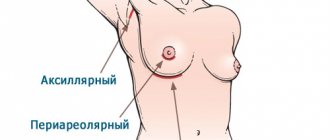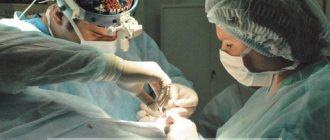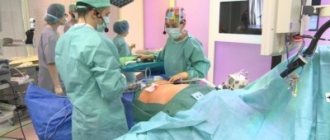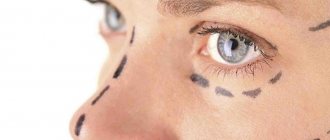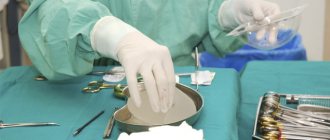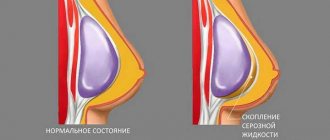Mastopexy is considered a modern plastic surgery that helps women restore the attractive appearance of their breasts by tightening them and making them rounder.
During surgery, the doctor completely changes the appearance of the breast and also removes part of the skin that is located above the areola and nipple. Typically, this type of lift is used if a woman only needs to tighten her breasts, and not make them several sizes larger.
Features of the operation
Mammoplasty involves surgery to enlarge, reduce or correct breasts. Correction involves lifting sagging breasts, eliminating asymmetry or improving their shape.
The operation involves marks after sutures. A scar will appear at the site of the breast incision. But how noticeable it will be depends mainly on the professionalism of the surgeon. But not only from this, because some patients may have an individual tendency to form keloid scars.
In addition to the presence of scars, women are concerned about the issue of subsequent rehabilitation after plastic surgery. This is due to the fear of pain, which lasts for 2-4 days after surgery. In this case, the doctor prescribes painkillers. Pain occurs even when performing simple movements or when coughing.
After surgery, swelling of the tissues is also observed, because of this you will have to wear special underwear for some time. Prohibitions include:
- Show of hands.
- Making sudden movements.
- Sleeping on your stomach.
- Driving vehicles.
- Carrying out household chores, even the simplest ones.
Methods of performing mammoplasty
Based on the goals set by the patient, the surgeon performs the operation in different ways. A lot depends on the choice: where the incisions will be made, how long it will take for the sutures to heal after mammoplasty, and whether complications should be expected during the operation. So in practice one of the methods of surgical intervention can be used:
- Transaxillary. The incision is made in the armpit area - the operation is quite complicated, there is a risk of bleeding. Not suitable for correction of asymmetrical breasts and displacement of natural folds.
- Periareolar. At the border between the pigmented areola of the nipple and the surrounding skin. Performed if the purpose of the operation is to tighten the breasts. This way, excess skin is removed, and the stitch heals for 6 months.
- Transabdominal. Insertion of the implant through the periumbilical area. A woman easily tolerates this method and in this case there are no noticeable scars left after mammoplasty.
- Submammary. The fold under the mammary gland is incised. The scar resembles a bra strip.
The doctor decides how to perform mammoplasty. It takes into account the individual characteristics of the patient, her health and the desired result.
Whether marks will remain after the procedure depends on how the woman takes care of the stitches after mammoplasty.
Scars after surgery
Mastopexy, like any other operation, is performed by cutting the tissue and then joining it, so it is impossible to do without scars. But you can carry out all the actions so that they are not very noticeable. But if you are promised a complete absence of scars, then most likely they are deceiving you.
If the operation is performed using the periareolar method, then after the operation, if the suture is applied correctly, a barely noticeable light scar remains, which only the woman herself can know about.
But such an operation is performed on patients with slight ptosis; if you lift small breasts using implants, the scars will be small and barely noticeable.
Why do breasts sag over time?
Under the influence of certain environmental factors and internal processes in a woman’s body, breasts change their appearance over time, but unfortunately, not for the better. These risk factors include:
· Age characteristics. Human skin contains collagen and elastic fibers, which, like a mesh, give it tone and elasticity. At a young age, these fibers are found in large quantities in the skin. Over time, collagen becomes thinner, connections between fibers are lost, and the mesh structure disappears. The skin significantly loses its elasticity. In addition to collagen fibers, over the course of many years of life, the force of gravity affects the breasts, this especially affects initially large breasts. According to the law of physics from the elementary school curriculum, we know that the heavier the object, the stronger the law of attraction acts on it.
· Pregnancy. During the 9 months that a woman is carrying a child, her body undergoes enormous changes. First of all, the hormonal background changes, which has a direct effect on the mammary glands. As a result, the breast tissue increases, which in the future will ensure lactation at a sufficient level.
· Natural (breast) feeding of children. The lactation process is accomplished through two mechanisms. Firstly, due to the action of the hormone prolactin, which begins to be actively produced at the end of pregnancy. This hormone acts on the mammary gland, on the secretory epithelium of the milk canals that produce milk. But for the establishment of lactation, the action of prolactin alone is not enough. In order for the mammary gland to produce a sufficient amount of milk, it must increase in volume. Even during pregnancy, hypertrophy of the mammary glands can be observed. After a woman decides to stop breastfeeding, a reverse process of breast development is observed (it seems to deflate). Stretched breast skin sags and looks completely unattractive;
· Major loss of body weight. Many women have noticed a pattern that when they gain weight, their breasts look more attractive, and when they lose weight, their size changes downwards. The fact is that a significant part of the mammary glands consists of subcutaneous fat. When you suddenly lose a lot of body weight, the fat layer disappears the fastest and the breasts become saggy.
658
Types of seams
Modern technologies make it possible to make scars after plastic surgery barely noticeable. Many modern clinics are equipped with special equipment that, using laser correction, can manipulate the mammary glands with a minimum of unpleasant consequences.
Scars can be divided according to their appearance into:
- Normotrophic - such marks have a light appearance and are more elastic.
- Hypertrophic - pink scars that rise slightly above the surface of the skin.
- Keloid - such scars (during a breast lift) rise above the skin level, have irregularities and are most noticeable.
Methods of tissue dissection during surgery are divided into the following types:
- Submammary dissection. An incision is made along the crease under the mammary gland. The implant is inserted through it. The scar subsequently resembles a mark from a bra.
- Transumbilical view. An incision is made in the umbilical area, and the implant is inserted through this passage. The main advantage of this method is its low trauma and a small mark near the navel.
- Periareolar. An incision is made from the areola of the nipple and along the pigmented area to the bottom of the breast. This method is suitable for minor surgical interventions. Subsequently, the scar is barely noticeable. The disadvantage of this technique is the risk of loss of nipple sensitivity.
- Axillary or axillary dissection. It is done in the armpit area. But there is a danger of bleeding in the sutures. Therefore, the method is not used so often.
To drain the fluid, a drainage tube is most often installed. Swelling and bruising may occur at the drainage insertion site. It is prohibited to try to eliminate postoperative consequences on the breast on your own. For example, some patients try to wet the sutures after mastopexy or lubricate them with cream. This is strictly prohibited.
To relieve swelling, your doctor will recommend applying compression bandages or wearing compression garments.
Self-absorbable sutures are not used in plastic surgery, so after a few days the stitches must be removed after the lift. During this process, the woman may feel discomfort, but there is usually no pain.
Where is the incision made for breast reduction?
Periareolar method.
An incision is made along the edge of the areola. This gives the highest possible aesthetic result. But it is used only with minimal intervention.
Vertical method.
An incision is made along the edge of the areola and down from the areola to the inframammary fold. Used for moderate hypertrophy.
Anchor method.
An incision is made along the edge of the areola, then down to the inframammary fold and in a semicircle under the fold. This cut resembles the shape of an anchor. The method is used for high-grade breast hypertrophy.
During breast reduction surgery, the doctor removes the areas where stretch marks have formed. Thus, after the operation, the breasts will not only be tightened, but also absolutely smooth, without flaws.
What determines the appearance of scars on the chest?
First of all, the professionalism of the surgeon plays a role here. The age of the patient and the ability of tissue to regenerate are also important. As you know, the older a person is, the slower healing occurs, and the greater the likelihood of scarring.
The wound healing process involves collagen and protein, which are produced in smaller quantities with age. Therefore, the type of mark and the speed of healing in young and mature women will have some differences.
Increased collagen production also affects the appearance of postoperative scars. In this case, keloid scars often form, requiring subsequent treatment, which is aimed at their resorption.
Silicone patch
Clinical studies have shown that silicone has a positive effect on the healing of scars (postoperative, hypertrophic, keloid, scars after cuts, burns and injuries). Silicone patches are also used to prevent scar growth.
Method of application : the patch is glued to the scar and is not removed during the entire course of therapy.
Advantages:
- perfect fixation;
- not noticeable under clothes;
- breathable;
- does not get wet;
- suitable for daily wear;
- can be reused (when removed, the patch does not lose its properties);
- one patch can be used for 7 days or more.
Rehabilitation after breast lift
After a surgical breast lift has been performed, a recovery period is necessary because the incisions take time to heal. Breast lift surgery lasts 2-3 hours using general anesthesia.
Immediately after surgery, the doctor applies a supportive bandage to the chest. After it is removed, it is recommended to wear special underwear that tightens the mammary glands after surgery.
In the first hours after surgery, you should not drink water to avoid swelling in the mammary glands. If you are unbearably thirsty, you can soak a cotton swab in water and blot your lips with it.
On the first day the patient does not get out of bed, on the second day the drainage tube is removed, and on the third day she can be discharged home.
But this does not mean that you can say goodbye to the clinic; at first you need to visit the doctor every day for dressings and treatment of postoperative scars. Prescribed physiotherapy will also be aimed at speedy healing of scars.
To prevent complications, it is also necessary to take painkillers, anti-inflammatory and antibacterial drugs. The average duration of therapy is 10-14 days. During this time, swelling and bruising disappear, and the joint at the incision site gradually becomes less noticeable.
The rehabilitation period will pass without complications if you follow the following rules:
- It is necessary to wear a supportive bra, it is advisable not to remove it for a certain time.
- Do not eat spicy food, drink alcohol or smoke for a month.
- For 1-1.5 months, abstain from intimacy.
- Avoid heavy lifting and physical activity for 3-5 months.
- For 3 months it is prohibited to visit baths, saunas and perform other warming procedures.
- For the first two weeks, do not wash your breasts or press them intensely.
- Sleep only on your back.
Correction of sutures after mammoplasty by cosmetology
If prevention does not protect against scars after mammoplasty, many patients turn to a cosmetologist for help.
The following procedures will help solve the problem:
- peeling with fruit acids;
- cryotherapy;
- microdermabrasion;
- laser resurfacing;
- steroid injections into the scar.
Each of these methods involves additional trauma to the skin. Thus, an injection into the damaged area will leave a hole from the syringe needle, cryotherapy involves cauterization with nitrogen, which causes necrosis of scar cells, and peeling simply cuts off the upper layer of the epidermis - a painful procedure that requires a rehabilitation period. The operating principles of laser resurfacing and microdermabrasion are similar to the work of peeling: in microdermabrasion, the crystal particles that remove the epidermal layer are simply smaller, and in laser resurfacing, their role is played by a laser beam.
Methods for treating and reducing scars after plastic surgery
If the operation was performed by a competent and experienced surgeon, and the patient followed all the doctor’s recommendations for postoperative care, then barely noticeable thin whitish stripes remain on the body at the site of the incisions. They do not cause any inconvenience and are practically invisible, even if you wear translucent underwear.
In this case, the woman’s age and the characteristics of her skin play a certain role. Sometimes the color of the scars may differ from the color of the skin.
But there are certain treatment methods to eliminate the bright appearance of scars:
- Injections of fillers and hormones. This technique is suitable for sunken (atrophied) scars. But the effect of the medicine ends after 4-12 months.
- Application of laser correction and chemical peels. This method is suitable for correcting rough and hypertrophied scars. At the same time, the skin is renewed and the scars become less noticeable. If we compare laser treatment and chemical peeling, the first option will be more effective. But both of these methods affect the condition of the scar for the better.
- It is recommended to resort to laser scar removal only 3 weeks after breast surgery. To eliminate scars, you will have to carry out 4 to 6 procedures, the interval between which is 3-4 weeks.
- Surgical interventions to remove scars. They are used for the following types of scars: hypertrophied, atrophic or keloid. Surgical removal of scars is performed if other methods have been ineffective. The old scar is excised and a new suture is applied using the latest techniques. Such gentle techniques contribute to better healing of incisions. After this, the scars on the skin become less noticeable.
To avoid such unpleasant consequences after a breast lift. As visible scars, you must follow all doctor's instructions both before and after surgery. Then toned breasts will bring you only joy. A breast lift without scars is impossible, they remain. But how noticeable they will be depends on many indicators, and above all, on the professionalism of the doctor.
Will there be scars and what are they?
Of course there will be scars. There are seamless correction methods, but this is a separate topic. In general, scars remain. But their thickness and length, as well as their location, make them almost invisible.
A keloid scar is a special type of scar, attributed to complications after mammoplasty, rough or improper fusion of wound edges. If healing proceeds normally, it will not form.
More often it occurs in people prone to the formation of keloids. Any surgical interventions not related to life saving are not recommended for them. Normally, if healing goes well, plastic surgeons do not leave tissue-deforming scars.
Slightly less often, this complication develops in women who neglect to wear compression garments during the rehabilitation period.
How is breast replacement performed?
Removal of a breast implant takes place in 3 stages under general anesthesia and lasts on average 1-2 hours. Moreover, it is worth understanding that if the patient does not want to install new prostheses, the operation will take longer. The following stages can be distinguished:
- Removal of a breast implant. After making incisions along the old scars, the doctor removes the silicone.
- Removal of the contracture capsule. This is fibrous tissue that forms around dentures. Partial resection can often be achieved.
- Installation of new dentures. Usually the doctor puts new inserts into the old “bed”, but if a woman wants a larger size, then the space is increased. At this stage, if necessary, a breast lift occurs.
Preparation for the operation begins 10 days in advance. During this period, it is necessary to stop taking aspirin, hormonal drugs, and not drink alcohol. You must stop eating 10 hours before the procedure. The date of the operation should also not fall during the period of menstruation.
Minuses
The disadvantages of mammoplasty include:
- rehabilitation period (it is worth considering the fact that the duration of the rehabilitation period increases with the size of the implanted implant);
- nausea after anesthesia;
- pain that is relieved with analgesics;
- possible insomnia;
- remaining scars (if properly cared for, this side effect can be avoided);
- changing your lifestyle (giving up active sports and going to the gym);
- quitting cigarettes;
- refusal to plan pregnancy (at least six months);
- During breastfeeding, you should take more careful care of your nipples.
Diagnosis before breast augmentation surgery
Breast augmentation surgery is carried out after a medical diagnosis, during which the method and method of carrying out the procedure, as well as the size and type of implants, are determined. At the initial stage, a consultation with a plastic surgeon is scheduled, accompanied by a visual and palpation examination.
During a conversation with the patient, the doctor finds out:
- what breast size does a woman want to have;
- does he plan to have children and lactation in the future?
- whether there was a family history of breast cancer;
- whether the woman has serious health problems;
- whether the patient takes hormonal medications, and in what quantity;
- is there a congenital predisposition to increased tissue scarring?
In addition to the survey and examination, siders (prostheses simulating silicone implants) are tried on. Try-on samples are placed in a woman’s underwear or under a woman’s clothes, and allow her to adjust the desired volume and shape of her future bust.
During fitting, the patient sees:
- how her breasts change;
- Will she be comfortable wearing such a bust?
The procedure helps the surgeon better understand the woman's desire and determine the method of operation. In addition to fitting, it is possible to use 3D modeling with siders.
Stage 2 of preparation for surgery is conducting diagnostic studies, during which it is determined whether plastic surgery is permissible.
Preliminary studies consist of:
- consultations with a mammologist, gynecologist, therapist;
- mammography;
- Ultrasound of the mammary glands;
- ECG;
- fluorography;
- blood tests for HIV, syphilis, hepatitis B, Australian antigen.
A doctor’s consultation, including fitting of siders and computer modeling, costs from 1000 to 1500 rubles. Many clinics perform this procedure free of charge. Analyzes and studies are included in the final cost of the operation. The price of mammoplasty in Moscow ranges from 200 to 600 thousand rubles. depending on the qualifications of the selected surgeon and the method of operation.
For a woman who has decided to undergo surgery, the doctor strongly recommends that she avoid the following for a month:
- from smoking;
- from drinking alcoholic beverages;
- from fatty, fried foods and large amounts of sweets;
- from taking dietary supplements, medications (especially hormonal drugs).
In the evening before mammoplasty you need:
- take a shower (you cannot lubricate your body with creams or lotions);
- remove manicure from nails (the patient’s blood pressure can be determined by the color of the nail plates during surgery);
- refuse dinner.
You need to come to the clinic in the morning hungry, wearing loose clothes with snaps or buttons.
